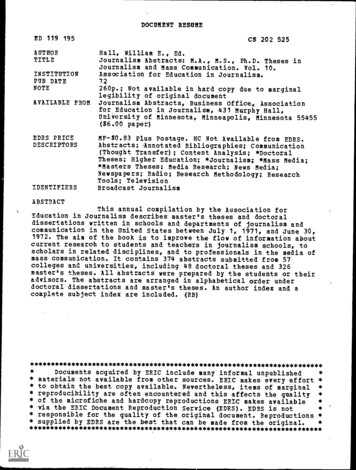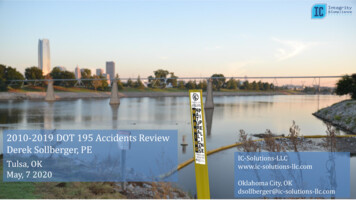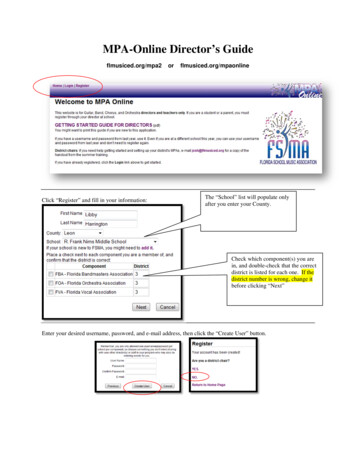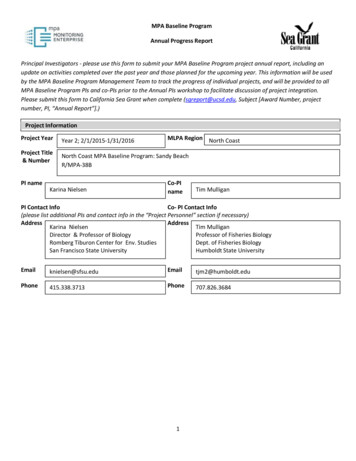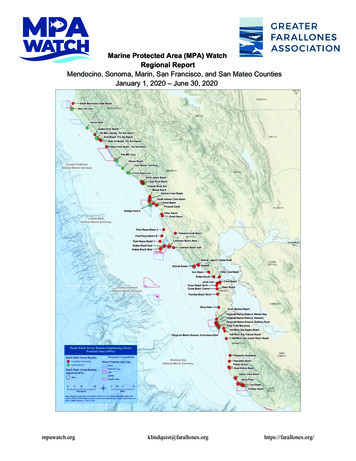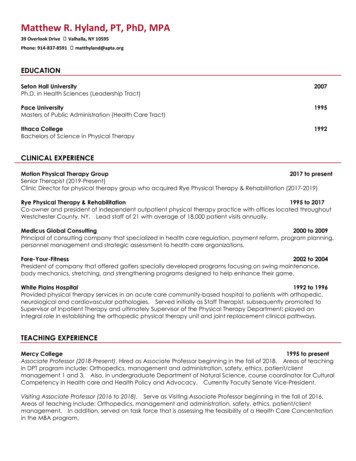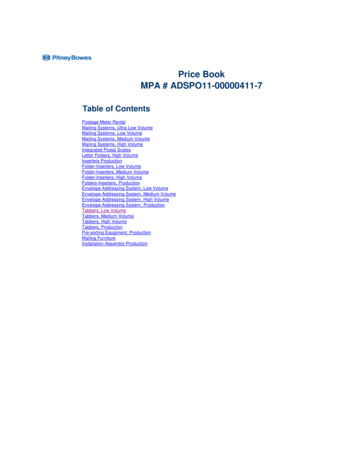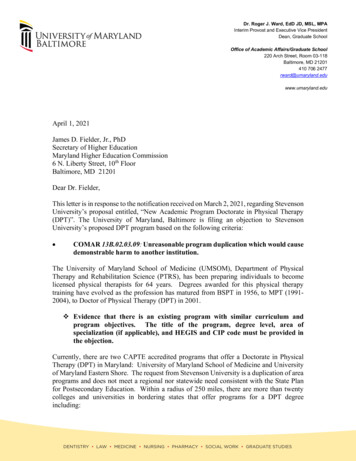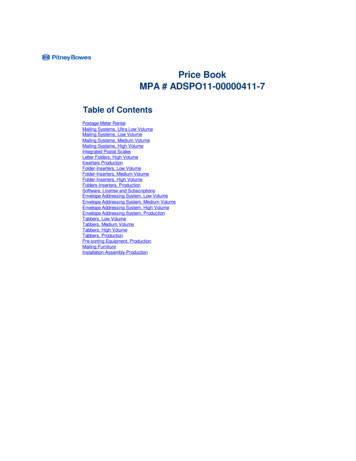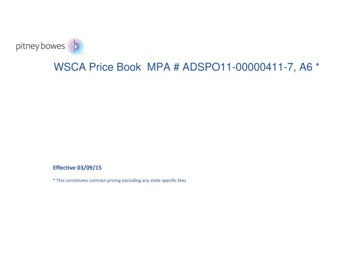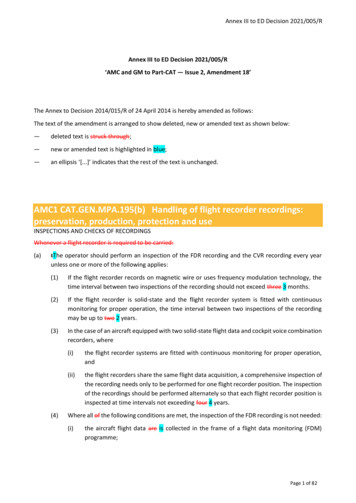
Transcription
Annex III to ED Decision 2021/005/RAnnex III to ED Decision 2021/005/R‘AMC and GM to Part-CAT — Issue 2, Amendment 18’The Annex to Decision 2014/015/R of 24 April 2014 is hereby amended as follows:The text of the amendment is arranged to show deleted, new or amended text as shown below:—deleted text is struck through;—new or amended text is highlighted in blue;—an ellipsis ‘[.]’ indicates that the rest of the text is unchanged.AMC1 CAT.GEN.MPA.195(b) Handling of flight recorder recordings:preservation, production, protection and useINSPECTIONS AND CHECKS OF RECORDINGSWhenever a flight recorder is required to be carried:(a)tThe operator should perform an inspection of the FDR recording and the CVR recording every yearunless one or more of the following applies:(1)If the flight recorder records on magnetic wire or uses frequency modulation technology, thetime interval between two inspections of the recording should not exceed three 3 months.(2)If the flight recorder is solid-state and the flight recorder system is fitted with continuousmonitoring for proper operation, the time interval between two inspections of the recordingmay be up to two 2 years.(3)In the case of an aircraft equipped with two solid-state flight data and cockpit voice combinationrecorders, where(4)(i)the flight recorder systems are fitted with continuous monitoring for proper operation,and(ii)the flight recorders share the same flight data acquisition, a comprehensive inspection ofthe recording needs only to be performed for one flight recorder position. The inspectionof the recordings should be performed alternately so that each flight recorder position isinspected at time intervals not exceeding four 4 years.Where all of the following conditions are met, the inspection of the FDR recording is not needed:(i)the aircraft flight data are is collected in the frame of a flight data monitoring (FDM)programme;Page 1 of 82
Annex III to ED Decision 2021/005/R(ii)the data acquisition of mandatory flight parameters is the same for the FDR and for therecorder used for the FDM programme;(iii)an inspection similar to the inspection of the FDR recording and covering all mandatoryflight parameters is conducted on the FDM data at time intervals not exceeding two 2years; and(iv)the FDR is solid-state and the FDR system is fitted with continuous monitoring for properoperation.(b)the operator should perform every five 5 years an inspection of the data link recording;(c)The operator should perform, at time intervals not exceeding 2 years, an inspection of the recordingof flight recorders other than an FDR, which are installed on an aircraft, in order to ensure compliancewith CAT.IDE.A.191 or CAT.IDE.H.191.(dc)wWhen installed, the aural or visual means for preflight checking of the flight recorders for properoperation should be used every day on each day when the aircraft is operated. When no such meansis available for a flight recorder, the operator should perform an operational check of this flightrecorder at time intervals not exceeding 150 flight hours or seven 7 calendar days of operation,whichever is considered more suitable by the operator.(ed) tThe operator should check every five 5 years, or in accordance with the recommendations of thesensor manufacturer, that the parameters dedicated to the FDR and not monitored by other meansare being recorded within the calibration tolerances and that there is no discrepancy in the engineeringconversion routines for these parameters.GM1 CAT.GEN.MPA.195(b) Handling of flight recorder recordings:preservation, production, protection and useINSPECTION OF THE FLIGHT RECORDERS’ RECORDINGS FOR ENSURING SERVICEABILITY(a)The inspection of recorded flight parameters the FDR recording usually consists of the following:(1)Making a copy of the complete recording file.(2)Converting the recording to parameters expressed in engineering units in accordance with thedocumentation required to be held.(3)Examining a whole flight in engineering units to evaluate the validity of all mandatoryparameters — this could reveal defects or noise in the measuring and processing chains andindicate necessary maintenance actions. The following should be considered:(i)when applicable, each parameter should be expressed in engineering units and checkedfor different values of its operational range — for this purpose, some parameters mayneed to be inspected at different flight phases; and(ii)(only applicable to an FDR) if the parameter is delivered by a digital data bus and the samedata are utilised for the operation of the aircraft, then a reasonableness check may besufficient; otherwise a correlation check may need to be performed:(A)a reasonableness check is understood in this context as a subjective, qualitativeevaluation, requiring technical judgement, of the recordings from a complete flight;andPage 2 of 82
Annex III to ED Decision 2021/005/R(B)(4)(b)a correlation check is understood in this context as the process of comparing datarecorded by the flight data recorder against the corresponding data derived fromflight instruments, indicators or the expected values obtained during specifiedportion(s) of a flight profile or during ground checks that are conducted for thatpurpose.Retaining the most recent copy of the complete recording file and the corresponding recordinginspection report that includes references to the documentation required to be held.When performing the CVR recording inspection of an audio recording from a flight recorder,precautions need to be taken to comply with CAT.GEN.MPA.195(f)(1a). The inspection of the CVR audiorecording usually consists of:(1)checking that the CVR flight recorder operates correctly for the nominal duration of therecording;(2)examining, where practicable, a samples of in-flight audio recording of the CVR from the flightrecorder for evidence that the signal is acceptable on each channel and in all phases of flight;and(3)preparing and retaining an inspection report.(c)[.](d)When inspecting images recorded by a flight recorder, precautions need to be taken to comply withCAT.GEN.MPA.195(f)(3a). The inspection of such images usually consists of the following:(1)checking that the flight recorder operates correctly for the nominal duration of the recording;(2)examining samples of images recorded in different flight phases for evidence that the images ofeach camera are of acceptable quality; and(3)preparing and retaining an inspection report.GM3 CAT.GEN.MPA.195(b) Handling of flight recorder recordings:preservation, production, protection and useCVR AUDIO QUALITYAdditional guidance material for performing the CVR recording inspection may be found in the document ofthe French Bureau d’Enquêtes et d’Analyses, titled ‘Guidance on CVR recording inspection’ and datedOctober 2018 or later.Examples of CVR audio quality issues and possible causes thereof may be found in the document of theFrench Bureau d’Enquêtes et d’Analyses, titled ‘Study on detection of audio anomalies on CVR recordings’and dated September 20153.AMC1 CAT.GEN.MPA.195(f)(1) Handling of flight recorder recordings:preservation, production, protection and useUSE OF AUDIO CVR RECORDINGS FOR MAINTAINING OR IMPROVING SAFETYPage 3 of 82
Annex III to ED Decision 2021/005/R(a)(b)(c)1The procedure related to the handling of audio recordings from flight recorders and of their transcriptscockpit voice recorder (CVR) recordings should be written in a document which should be documentedand signed by all parties (airline management aircraft operator, crew member representativesnominated either by the union or the crew themselves, maintenance personnel representatives ifapplicable). This procedure should take into account Regulation (EU) 2016/6791 and as a minimum,define:(1)the method to obtain the consent of all crew members and maintenance personnel concerned;(2)an access and security policy that restricts access to audio recordings from flight recorders andtheir transcripts CVR recordings and identified CVR transcripts to specifically authorised personsidentified by their position;(3)a retention policy and accountability, including the measures to be taken to ensure the securityof audio recordings from flight recorders and their transcripts the CVR recordings and CVRtranscripts and their protection from misuse. The retention policy should specify the period oftime after which such audio CVR recordings and identified CVR transcripts are destroyed;(4)a description of the uses made of audio recordings from flight recorders and their transcriptsthe CVR recordings and of their transcripts;(5)the participation of flight crew member representatives in the assessment of audio recordingsfrom flight recorders and their transcripts the CVR recordings or their transcripts;(6)the conditions under which advisory briefing or remedial training should take place; this shouldalways be carried out in a constructive and non-punitive manner; and(7)the conditions under which actions other than advisory briefing or remedial training may betaken for reasons of gross negligence or significant continuing safety concern.Each time an audio recording file from a flight recorder a CVR recording file is read out under theconditions defined by CAT.GEN.MPA.195(f)(1):(1)parts of the CVR audio recording file that contain information with a privacy content should bedeleted to the extent possible, and it should not be permitted that the detail of information witha privacy content is transcribed; and(2)the operator should retain, and when requested, provide to the competent authority:(i)information on the use made (or the intended use) of the CVR audio recording file; and(ii)evidence that the persons concerned consented to the use made (or the intended use) ofthe CVR audio recording file.The safety manager or the person identified by the operator to fulfil this role should be responsible forthe protection and use of the CVR recordings and of their transcripts, audio recordings from flightrecorders and their transcripts, as well as for the assessment of issues and their transmission to themanager(s) responsible for the process concerned.Regulation (EU) 2016/679 of the European Parliament and of the Council of 27 April 2016 on the protection of natural personswith regard to the processing of personal data and on the free movement of such data, and repealing Directive 95/46/EC (GeneralData Protection Regulation) (OJ L 119, 4.5.2016, p. 1).Page 4 of 82
Annex III to ED Decision 2021/005/R(d)In case a third party is involved in the use of audio recordings from flight recorders CVR recordings,contractual agreements with this third party should, when applicable, cover the aspects enumeratedin (a) and (b).GM1 CAT.GEN.MPA.195(f)(1) Handling of flight recorder recordings:preservation, production, protection and useUSE OF CVR RECORDINGS FOR MAINTAINING OR IMPROVING SAFETY(a)The CVR is primarily a tool for the investigation of accidents and serious incidents by investigatingauthorities. Misuse of CVR recordings is a breach of the right to privacy and it works against an effectivesafety culture inside the operator.(b)It is noteworthy that the flight data recorder (FDR) may be used for a flight data monitoring (FDM)programme; however, in that case the principles of confidentiality and access restriction of the FDMprogramme apply to the FDR recordings. Because the CVR is recording the voices of the crew andverbal communications with a privacy content, the CVR recordings must be protected and handledwith even more care than FDM data.(c)Therefore, the use of a CVR recording, when for purposes other than CVR serviceability or those laiddown by Regulation (EU) No 996/2010, should be subject to the free prior consent of the personsconcerned, and framed by a procedure that is endorsed by all parties and that protects the privacy ofcrew members and (if applicable) maintenance staff.AMC1 CAT.GEN.MPA.195(f)(1a) Handling of flight recorder recordings:preservation, production, protection and useCVR RECORDING INSPECTION OF AUDIO RECORDINGS FOR ENSURING SERVICEABILITY(a)When an inspection of the audio recordings from a flight recorder the CVR recording is performed forensuring audio quality and intelligibility of recorded communications:(1)the privacy of the audio CVR recordings should be ensured (e.g. by locating the CVR replayequipment in a separated area and/or using headsets);(2)access to the CVR replay equipment should be restricted to specifically authorised personsidentified by their position;(3)provision should be made for the secure storage of the CVR recording medium, the audio CVRrecording files and copies thereof;(4)the audio CVR recording files and copies thereof should be destroyed not earlier than 2 twomonths and not later than 1 one year after completion of the CVR recording inspection of theaudio recordings, except that audio samples with no privacy content may be retained forenhancing this the CVR recording inspection (e.g. for comparing audio quality);Page 5 of 82
Annex III to ED Decision 2021/005/R(5)(b)only the accountable manager of the operator, and, when identified to comply withORO.GEN.200, the safety manager should be entitled to request a copy of the audio CVRrecording files.The conditions enumerated in (a) should also be complied with if the inspection of the audio CVRrecordings is subcontracted to a third party. The contractual agreements with the third party shouldexplicitly cover these aspects.AMC1 CAT.GEN.MPA.195(f)(3) Handling of flight recorder recordings:preservation, production, protection and useUSE OF IMAGES FROM THE FLIGHT CREW COMPARTMENT FOR MAINTAINING OR IMPROVING SAFETY(a)(b)The procedure related to the handling of images of the flight crew compartment that are recorded bya flight recorder should be documented and signed by all parties involved (aircraft operator, crewmember representatives nominated either by the union or the crew themselves, maintenancepersonnel representatives if
(b) the operator should perform every five 5 years an inspection of the data link recording; (c) The operator should perform, at time intervals not exceeding 2 years, an inspection of the recording of flight recorders other than an FDR, which are installed on an aircraft, in order to ensure compliance with CAT.IDE.A.191 or CAT.IDE.H.191.
